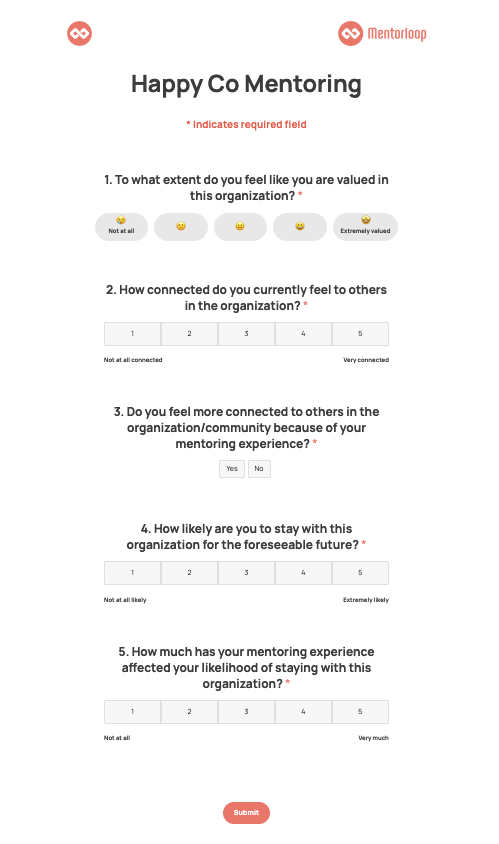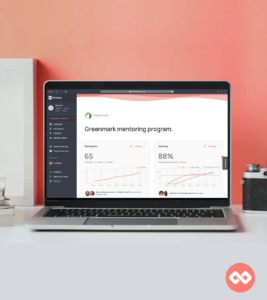What’s the right way to measure your mentoring program? In truth, there are many different ways to measure a mentoring program’s success based on its goals. So, we thought we’d provide some examples of the mentoring program goals our own customers are using so you can see what works for different types of programs—and determine what might work for your own.
Why Setting Mentoring Program Goals is Important
For organizations:
Quite simply, setting program goals prior to launch is important for ensuring that the program is meeting its desired outcomes.
First, it ensures that the mentoring program aligns with the organization’s overall objectives and mission. By defining specific goals in the planning stage of a mentoring program, it can be tailored to address the organization’s unique needs and challenges. This is important because mentoring programs aren’t a one-size-fits-all affair. And while there are best practices for running a mentoring program, it’s just as important to tailor your program to what your organisation and people need.
Second, setting mentoring program goals prior to launch enables program coordinators to measure the success of the program and make any necessary adjustments if needed. Setting your goals allows you to track progress and outcomes against them so you can determine the impact it’s making. Finally, having well-defined goals is key to generating a level of accountability, not just for you, the program coordinator. It also helps you ensure that the tools you’re using, like mentoring software such as Mentorloop, are delivering on what was promised.
Setting goals ensures that the program is running efficiently and that all parties are working towards the same objectives.
For your mentoring participants:
Setting your mentoring program’s goals ensures that all participants involved have an understanding of what is expected from them too.
Setting mentoring program goals is essential for both mentors and mentees because it provides direction and focus for their mentoring relationship.
For mentees, setting goals enables them to identify specific areas where they want to improve and develop. It also helps them to stay motivated and accountable for their own learning and growth. It also gives their mentor something to work with and something to inform their mentoring sessions.
For mentors, having the mentoring program’s goals to look to helps them to identify areas where they can provide guidance and support to their mentee. It also allows them to create a structured approach to mentoring, which can increase the effectiveness of their interactions.
When both mentors and mentees have a clear understanding of the goals of the mentoring program, they are more likely to have a successful and meaningful mentoring relationship. By working together to achieve their goals, mentors and mentees can build a trusting and supportive relationship that can benefit both their personal and professional development.
Not only does it provide direction but it also encourages everyone to be on the same page as far as what they hope to achieve throughout their mentorship experience. By setting clear expectations, mentors, mentees, and organizations can reach their set targets while also giving everyone an enjoyable learning experience.
Your mentoring program goals give you a base level to work from
Prior to launching your mentoring program, starting with a benchmark of what you’d like to achieve by running your mentoring program can assist in designing it, coming up with creative ways to stimulate engagement from participants, and help you communicate to your own stakeholders on how it’s all going and if the ROI is there. This way, you’re not starting blind – you have a clear picture of where you want to be and what steps you need to take to get there.
For example, if one of your program goals is to facilitate better collaboration between teams and departments, a good engagement and networking activity would be a hackathon-style event where participants from different departments can work on a solution for a hypothetical problem or develop a project. But if for a program that has improving cultural literacy within the organization as one of its goals, it’ll be a good idea to hold mixer events on days that are relevant to participants’ cultures where everyone else can learn about them and share in the culture in question. (e.g. Indian Holi, Philippine Ati-Atihan, Ramadan, etc.)
All of the little activities and tasks that come with running a mentoring program start with knowing where you want to go. Goal-setting allows you to begin with the end in mind, giving you a clear picture of what’s needed to get there.
Setting Mentoring Program Goals and How to Measure Them
Each program has different goals. Therefore, it’s important for you to first pause and reflect on what success might look like for your mentoring program. Ask yourself: What needs to happen in order for you to say the program is effective?
Here are some examples of goals that our customers have used for their own programs that you may want to strive for yourself, and some suggestions on how to measure them.
Track Progress Seamlessly with Mentorloop Surveys
Setting goals is one thing, knowing whether you’re achieving them is another. That’s where Mentorloop Surveys come in!
Surveys give you real-time feedback from mentors and mentees, so you can measure sentiment, track progress, and adapt your program as it runs.
Mentorloop Pro customers can access a library of templated survey questions.
Mentorloop Enterprise customers unlock the ability to create fully custom questions, so you can measure exactly what matters to your program and your organization.
With Surveys built directly into Mentorloop, you can keep a pulse on participant experience and program outcomes without juggling external tools — making measurement effortless.
Improving Retention
An effective mentoring program has been shown to increase retention to 69% and 72% for mentors and mentees, respectively, compared to just 49% for employees who don’t participate. So this one is pretty straightforward. Check your organisation’s retention rates from the before times, and after you’ve implemented your program.
It’s also valuable to track engagement and job satisfaction levels of participants as these are strong indicators of intent to stay with the organization. To truly measure impact, we recommend running a benchmarking survey at the start of your program and a follow-up at the end to capture shifts in sentiment and outcomes.
Here’s a simple example of what these surveys could look like, as well as some example questions you could use:


More Minorities in Leadership
One goal many of our Program Coordinators strive towards is to increase the number of minorities in leadership over time—what we call Diversity Equity & Inclusion (DEI).
This doesn’t necessarily mean that they want to see results instantly at the close of a mentoring program, but they want to set individuals on the path to leadership, especially when the organisation’s leadership group has historically been less diverse than they want.
First, the organization can track the number of minorities who are selected for leadership positions, special projects, or put on accelerator paths before and after the mentoring program is implemented. You then need to continue to measure this regularly. This can provide a direct measure of the program’s impact on increasing diversity in leadership.
Second, the organization can conduct surveys to assess the mentees’ perception of the program’s effectiveness in helping them develop the skills and knowledge needed to advance to leadership positions. Ask questions about how helpful they found the program, how confident they feel in their abilities to step into a leadership role before and after the program, and whether they felt the mentoring program gave them valuable support in building leadership skills.
Third, the organization can track the retention rates of mentees from minority backgrounds who participate in the program. If mentees feel supported and see a clear path to advance in the organization, they may be more likely to stay with the organization and continue to develop their careers.
Questions to ask on your survey:
How strongly do you feel the mentoring program helped create fair leadership opportunities for individuals from diverse backgrounds?
(Scale: Not at all → A great deal)Do you feel the program increased representation of minorities in leadership pipelines?
(Scale: Strongly disagree → Strongly agree)How confident are you that the organization values diverse voices when identifying future leaders?
(Scale: Not confident at all → Extremely confident)
Cross-Departmental Relationships
One amazing advantage of mentoring programs is the cross-departmental relationships that are formed. In fact, many of our customers strive to build and strengthen these cross-team and cross-departmental relationships. Here are a few ways you can measure if you’re tracking towards this goal and this is something you’d like to happen for your program and organisation too.
You can use surveys to measure if these types of relationships are flourishing. Ask your people about how connected they feel to the organisation outside of their immediate team and environment, or how much they feel their cross-team and cross-department relationships have improved.
You can also measure how many new projects are popping up that take full advantage of these relationships and how successful they are compared to previous years.
The organization can also evaluate the quality of cross-departmental projects and initiatives that are undertaken after the program is implemented. If there is an increase in the number of successful projects that involve collaboration across different departments, it may indicate that the program is achieving its goal.
Questions to ask on your survey:
How connected do you feel to colleagues outside of your immediate team or department?
(Scale: Not at all connected → Very connected)To what extent has your mentoring relationship helped you build cross-departmental connections?
(Scale: Not at all → A great deal)How confident are you in collaborating with colleagues from other departments since joining the program?
(Scale: Not confident at all → Extremely confident)
Career Support and Development
Are participants of your mentoring program applying for and getting promotions, special projects, or transfers? This is a great goal to measure, as it shows that participants are taking their mentors’ advice and actually implementing it by reaching for new heights in your organisation.
The organization can also monitor the retention rates of mentees who participate in the program. If mentees feel supported in their career development and see a clear path for advancement within the organization, they may be more likely to stay and continue to develop their careers.
Another metric you can track is the career advancement of mentees who participated in the program compared to those who did not. This can provide a direct measure of the program’s impact on career development.
Questions to ask on your survey:
How confident are you in your ability to progress in your career within this organization?
(Scale: Not confident at all → Extremely confident)To what extent has your mentoring relationship provided guidance for your career development?
(Scale: Not at all → A great deal)Do you feel you have greater access to career opportunities as a result of this mentoring program?
(Scale: Strongly disagree → Strongly agree)
Creating a Support Network
Is the goal of your mentoring program to create an excellent support network for your employees? Checking engagement rates on your Dashboard and administering regular surveys can help you get an idea of how you’re performing.
At the organizational level, you can monitor the level of engagement and participation in networking events and activities that are organized as part of the mentoring program.
Additionally, the organization can track the long-term impact of the program by assessing participant retention rates and their success in achieving their career goals.
Questions to ask on your survey:
How supported do you feel in your role through the relationships you’ve built in this program?
(Scale: Very unsupported → Very supported)To what extent has the mentoring program helped you build a professional support network?
(Scale: Not at all → A great deal)Do you feel more comfortable seeking advice and support within the organization since joining the program?
(Scale: Strongly disagree → Strongly agree)
Successful Onboarding
If you want to leverage your mentoring program as a method to ease and enrich your onboarding process, you can easily check the pulse of how new hires are responding now vs. before you implemented your program. You can also ask more seasoned team members how they found their onboarding experience vs. the feedback new hires are providing now.
You can also monitor the retention rates of new employees who participate in the program. If new employees feel supported during the onboarding process, they are more likely to stay with the organization and become valuable long-term employees.
Another useful thing to measure is the time it takes for new employees to become fully productive and integrated into their roles before and after the mentoring program is implemented. This can provide a direct measure of the program’s impact on improving onboarding and getting new hires up to speed faster.
Questions to ask on your survey:
How supported did you feel during your onboarding experience?
(Scale: Very unsupported → Very supported)How confident do you feel in performing your role after completing onboarding?
(Scale: Not confident at all → Extremely confident)To what extent did your mentoring relationship help you integrate into the team and organization?
(Scale: Not at all → A great deal)
Overall, by collecting these kinds of feedback and data, and analyzing data on these KPIs, program coordinators can determine whether their mentoring program is tracking well towards these organizational goals.
Achieving Your Mentoring Program Goals Starts Before You Launch
At Mentorloop we’re fans of beginning with the end in mind for the reasons we discussed previously. That’s why we created Program Themes for Mentorloop Pro. Program themes help you commit to your goals before you launch and ensure the goals you set at the beginning are at the heart of your program.
So what are Program Themes and how do you go about choosing one?
Each Program Theme is built on the success of hundreds of programs that have gone before you. There are three themes based on the most common use cases for mentoring programs: Classic, Diversity Equity & Inclusion, and Community.
Program Themes dictate the profile information you collect from your participants, as well as the way that they’re matched. Each Program Theme generates a premade sign-up form and set of matching rules designed to steer your program towards your desired mentoring program goals, so you won’t have to start from scratch.
All themes ask the basics:
- Gender and Pronouns
- Job Title
- Work Experience
- Location
- Ice Breakers
- LinkedIn Profile
- Participant Bio
However, each theme would have specific additional fields added to the sign-up form, as well as differences in the matching rules that inform the Recommended Matches.
The Classic Theme
This theme is perfect for first-time program coordinators and a go-to for internal workplace mentoring programs that aim to connect employees to empower skills development and knowledge sharing or strengthen interdepartmental relationships. It’s also a great choice for programs that have multiple goals, such as:
- Strengthening cross-department working relationships
- Connecting employees from different branches, regions, etc.
- Knowledge sharing between senior and junior employees
- General career development and guidance
The Diversity Equity & Inclusion (DEI) Theme
As the name suggests, this theme is perfect for programs that are dedicated to promoting diversity, equity, and inclusion outcomes, whether it be for workplaces, industry associations, universities, or communities.
Programs that use the DEI theme would have goals similar to the following:
The Community Theme
This theme is great for industry associations and community organisations that run mentoring programs to foster better participation outcomes or connect people with shared advocacy, purpose, or field of interest.
Mentoring programs that use the community theme have goals such as:
- Empowering members of a field of interest or study to share ideas to promote innovation
- Making personal and professional guidance available for members of a specific interest group (e.g. formerly incarcerated persons, parents coming back from parental leave, new immigrants entering the workforce)
Mentorloop Helps You Smash Your Mentoring Program Goals
As you prepare for your program, you should always keep your goals top of mind. Thankfully, Mentorloop can help you do just that by taking away the worry of managing engagement, participant admin, and feedback collection, and even making reporting easier so you can focus your efforts on achieving those goals.
From getting started to scaling, Mentorloop has everything you need to run a goal-focused mentoring program that not only ticks your organization’s goals, but that of your mentors and mentees as well.
Keen to get started? With Mentorloop Pro, you’re only 4 steps away from launching your best mentoring program yet!


![[Webinar Kit] Building the Blueprint: Designing Your Best Mentoring Program Yet Learn how to design and build a mentoring program that serves your organization’s goals, engages participants, and delivers measurable outcomes.](https://no-cache.hubspot.com/cta/default/4058869/interactive-190169165857.png)


